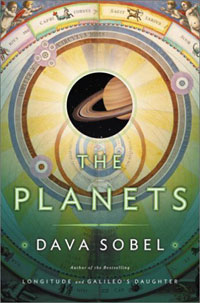|
|
Review: The Planets
by Jeff Foust
Monday, December 19, 2005
The Planets
by Dava Sobel
Viking, 2005
Hardcover, 270 pp., illus.
ISBN 0-670-03346-0
US$24.95/C$35
There is no shortage of books about the solar system. A visit to even a small bookstore will likely reveal a better part of bookshelf’s worth of books about the solar system, either in general or about specific planets. Many of these books, particularly the coffee-table tomes, follow a similar formula: a limited amount of text shoehorned around full-color illustrations. Even more conventional books freely incorporate a liberal amount of images to accompany the text. (Many astronomy books also adopt this same approach; the formula can be repeated continuously for both as new images from the Hubble Space Telescope and spacecraft missions become available.) However, is it possible to write an introductory book about the solar system from a much more literary approach, and without relying on stunning images? That’s the attempt made by noted author Dava Sobel in her latest book, The Planets.
Sobel, best known for her 1995 book Longitude, attempts to encapsulate both the history of our knowledge of the solar system and basic descriptions of each world into a book that can be read in a single evening. The book is, in essence, a collection of independent essays, one for each planet of the solar system. (The Sun and Moon each get their own chapters, since in antiquity these worlds were thought to orbit the Earth; Uranus and Neptune, however, have to share a single chapter.) The Planets lives up to it name in another respect: there is little in the book about asteroids and comets, although Kuiper Belt Objects are discussed briefly in the chapter on Pluto. There are only a few illustrations in the entire book, principally reproductions of historical illustrations by Galileo and Huygens (the astronomers, not their eponymic spacecraft.) In fact, there are far more poems in the book than illustrations.
| There are only a few illustrations in the entire book, principally reproductions of historical illustrations. In fact, there are far more poems in the book than illustrations. |
Sobel avoids falling into a pattern by taking a different approach to each chapter: the essay about Earth focuses on the efforts of mapmakers and explorers to get a true measure of the planet (harkening back ever so slightly to her work in Longitude) while Jupiter gets an astrological theme, discussing in passing the astrological charts of both Galileo the astronomer (who cast horoscopes for his patrons) and Galileo the spacecraft. Sobel attempts to get particularly creative with Mars: the chapter is written from the first-person perspective of ALH 84001, the Martian meteorite that became famous because of its controversial evidence of past life on Mars. However, Sobel overreaches with this particular literary conceit: whole pages go by without the use of the first-person voice, and even when used it is not very effective. Likewise, much of the Uranus/Neptune chapter is in the form of an 1847 “letter” from Caroline Herschel to pioneering American astronomer Maria Mitchell; only in the notes section in the back of the book, which includes more details about topics discussed in the main text, do we learn that this letter is a work of fiction.
The Planets is clearly intended for those not already familiar with the makeup of the solar system: the typical reader of this publication will likely learn little new about the planets from this book. (Sobel writes in the book’s acknowledgments that she was inspired in part to write this book when her agent asked her to explain the difference between the solar system and the Milky Way.) However, for someone curious but not knowledgeable about the solar system, and less likely to be impressed by a typical photo-gallery approach to the topic, The Planets makes for an enlightening and interesting read.
Jeff Foust (jeff@thespacereview.com) is the editor and publisher of The Space Review. He also operates the Spacetoday.net web site and the Space Politics weblog. Views and opinions expressed in this article are those of the author alone, and do not represent the official positions of any organization or company, including the Futron Corporation, the author’s employer.
|
|
